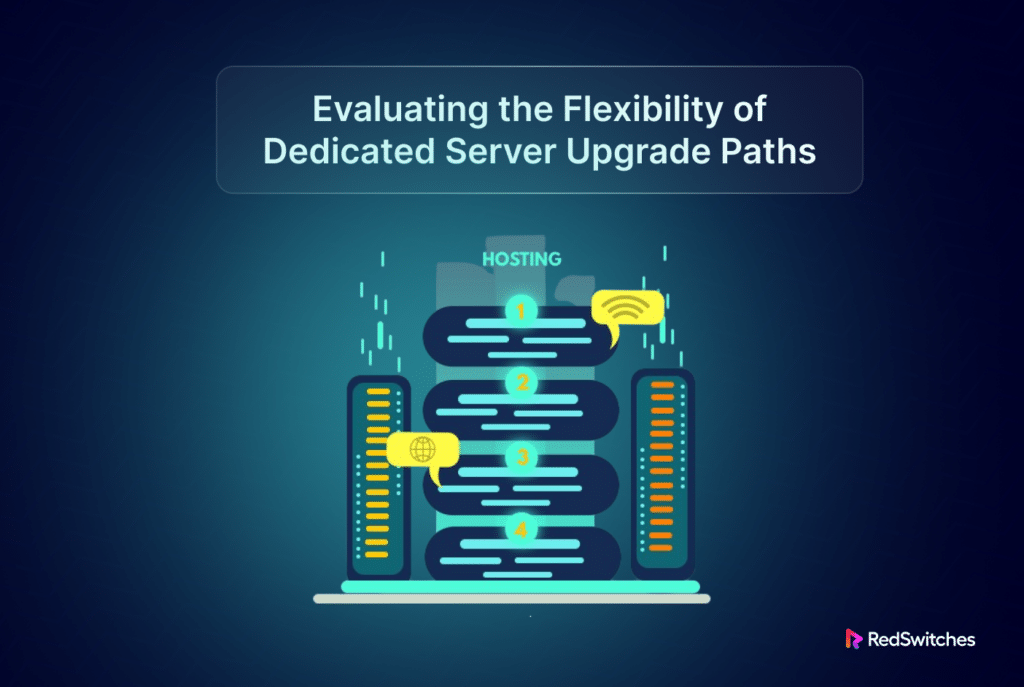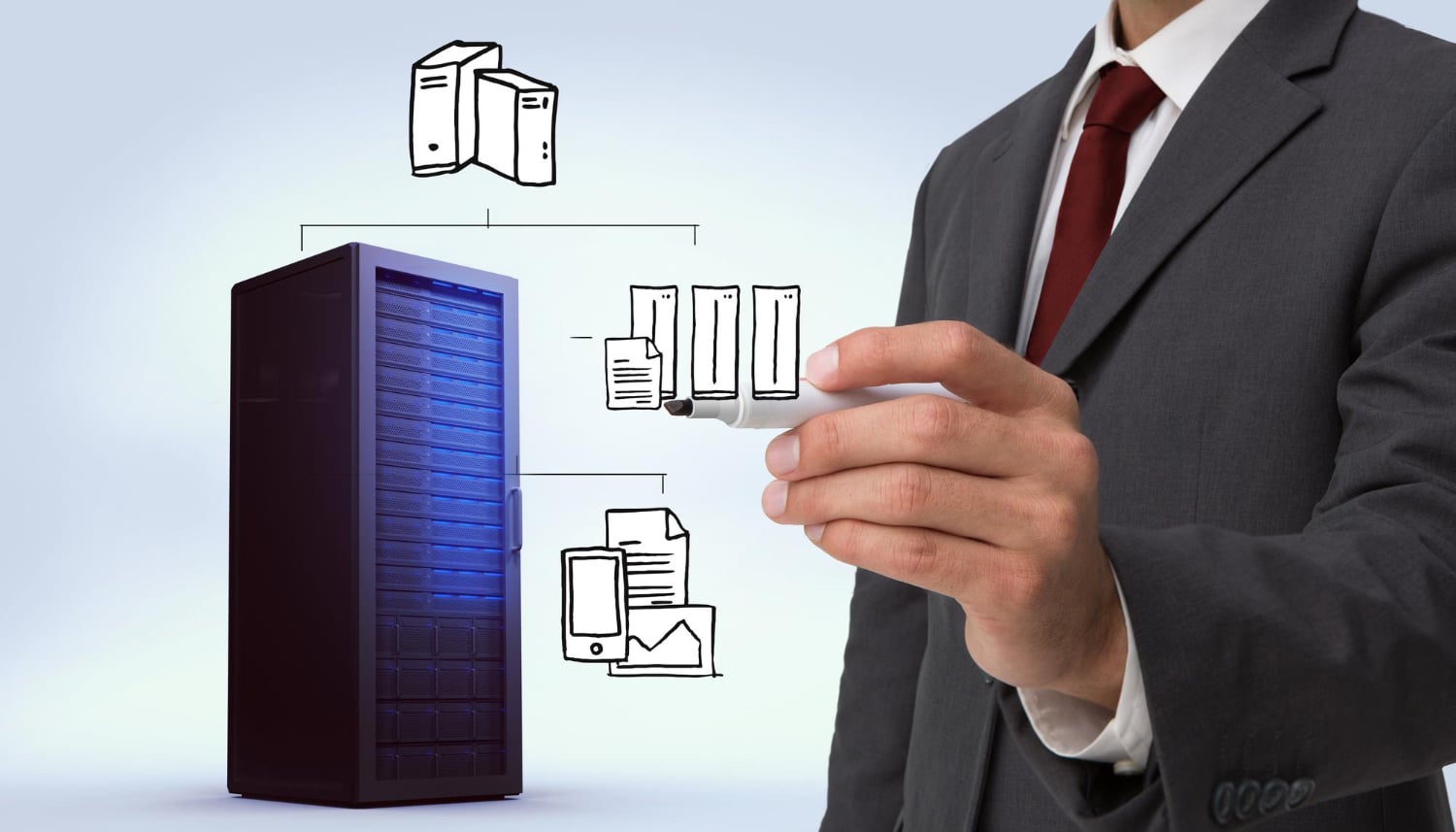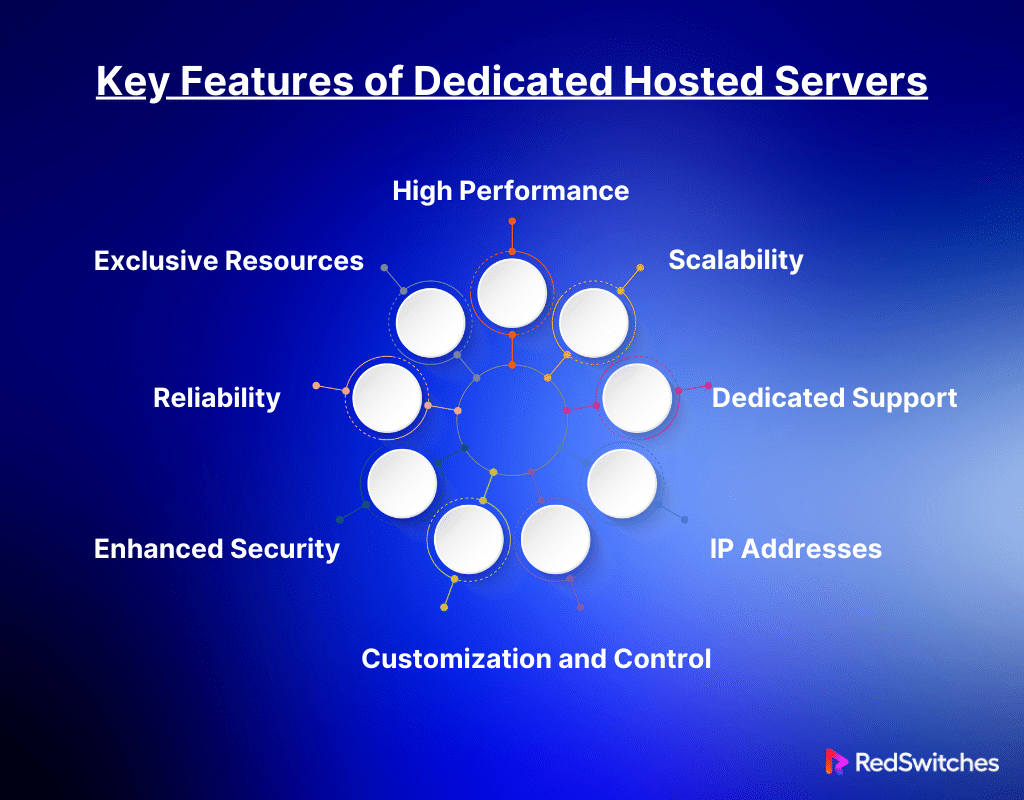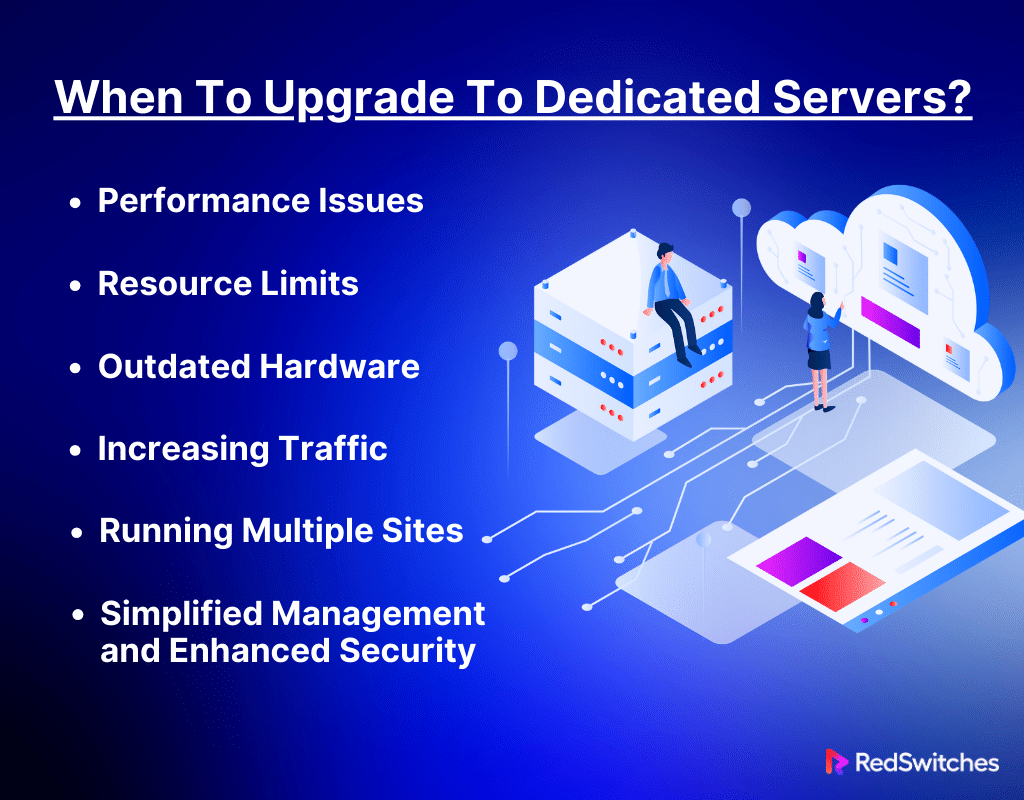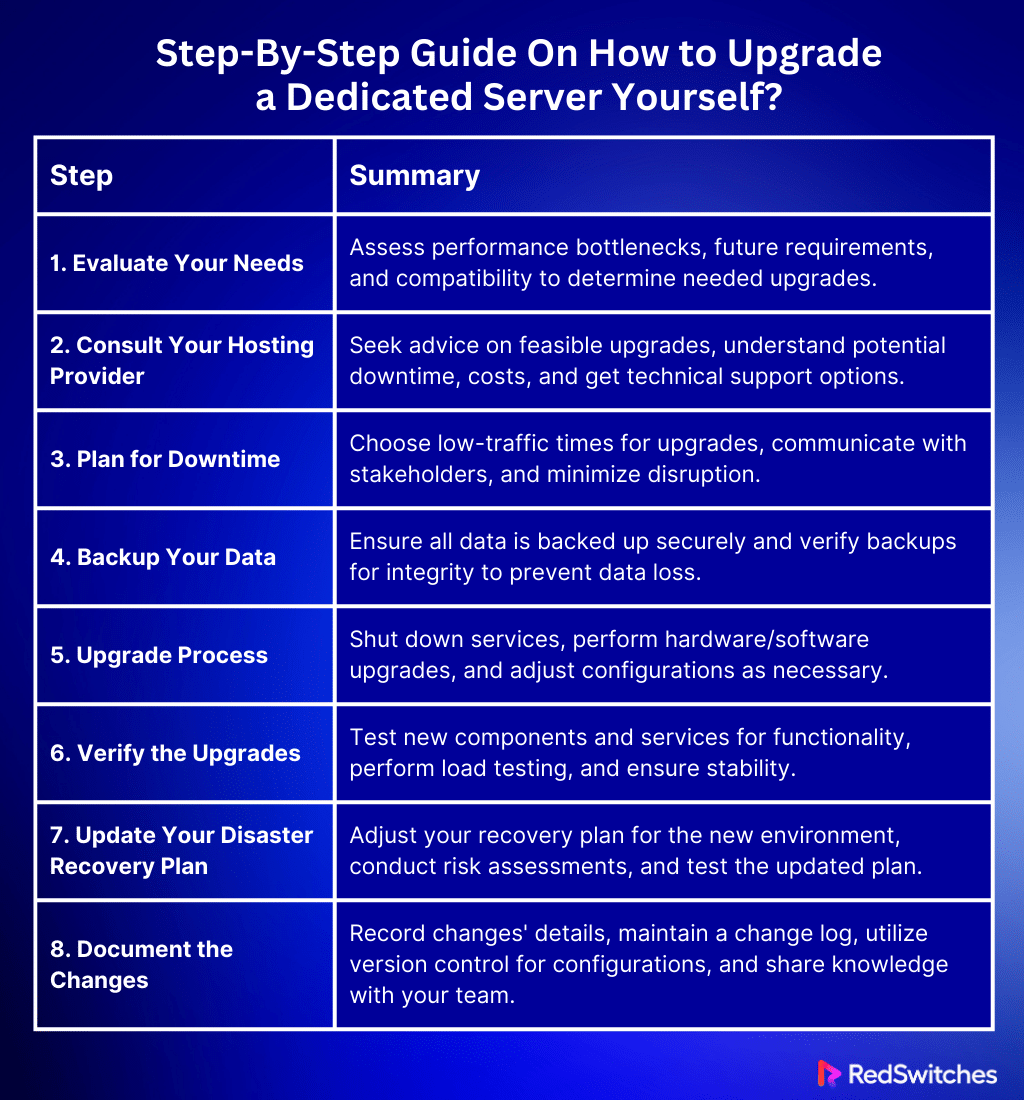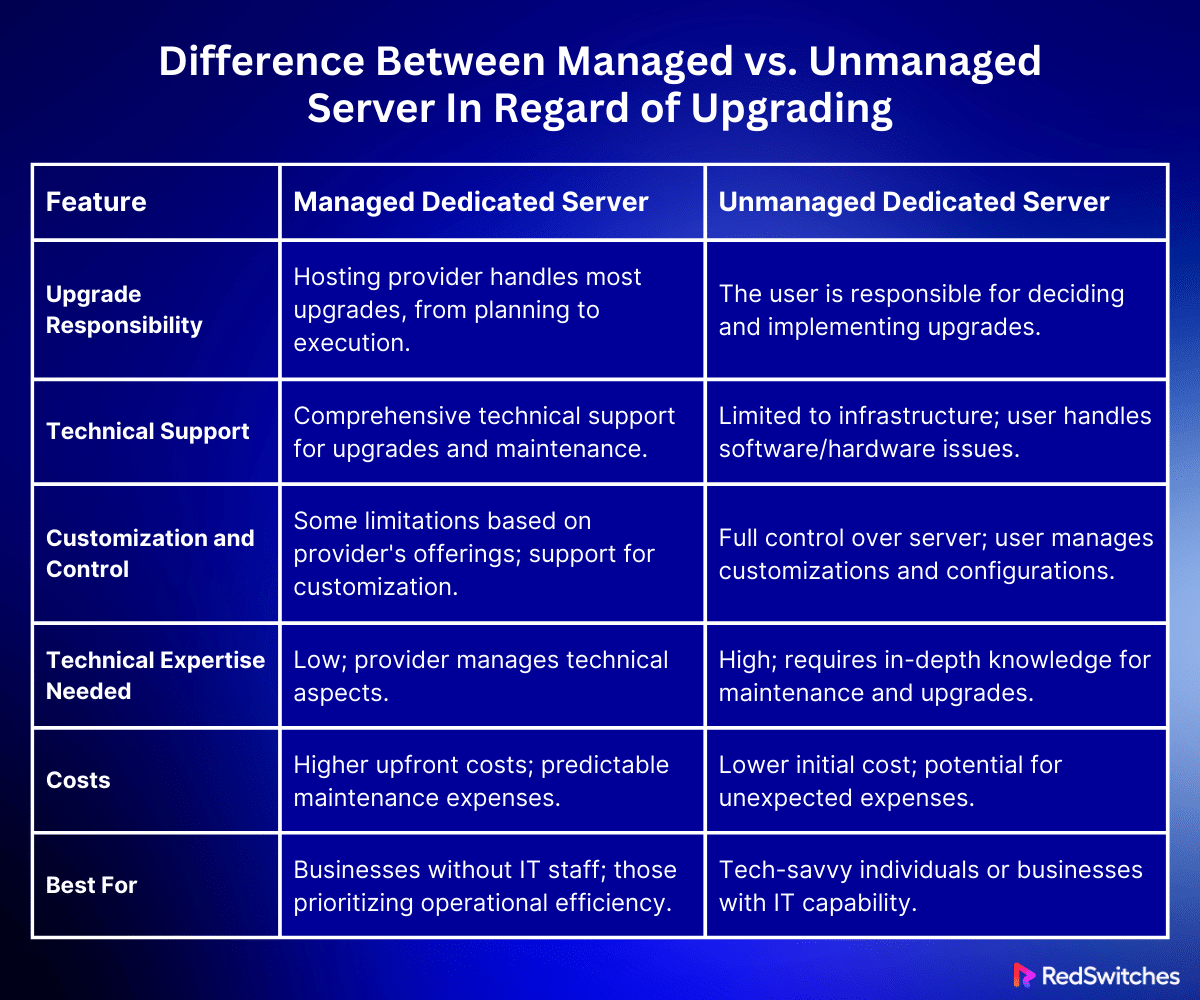Key Takeaways
- Dedicated servers provide unmatched control, power, and security essential for growing businesses.
- Flexibility in upgrading dedicated hosted servers is crucial for scaling IT infrastructure to meet evolving business demands.
- Key features of dedicated hosted servers include high performance, scalability, customizable security, dedicated support, and exclusive resources.
- The right time to upgrade to a dedicated physical server is when current hosting cannot support growth and requires more resources and security.
- Dedicated hosted servers address performance issues and resource limits often encountered with shared hosting, ensuring smoother, more reliable operations.
- Managed servers offer hassle-free management, including setup, maintenance, and technical support, ideal for businesses without an IT team.
- Unmanaged servers provide more control and flexibility but require significant technical knowledge for management and upgrades.
- Choosing between managed and unmanaged servers depends on a business’s technical expertise and management preferences.
- RedSwitches offers managed server solutions with enhanced security, superior performance, scalability, and dedicated support.
- Switching to a managed entire server solution allows businesses to focus on growth while benefiting from a robust, hassle-free online presence.
In the fast-paced world of digital technology, dedicated hosted servers are the backbone of many businesses. These servers offer unmatched control, power, and security. Yet, as businesses grow, their needs evolve.
Reflecting this growth, the global market for dedicated server hosting was valued at $14.26 billion in 2022. It is projected to expand at a compound annual growth rate (CAGR) of 18.9% over the forecast period.
Whether you’re tech-savvy or new to the topic, we aim to ensure you’ll find this article valuable in making informed decisions for your business’s digital infrastructure that How to Upgrade Your Dedicated Server.
Table Of Contents
- Key Takeaways
- What Are Dedicated Servers?
- When To Upgrade To Dedicated Servers?
- Step-By-Step Guide On How to Upgrade a Dedicated Server Yourself?
- Difference Between Managed vs. Unmanaged Server In Regard of Upgrading
- Unveiling Managed Server Solutions
- Conclusion
- FAQs
What Are Dedicated Servers?
Credits: Freepiks
Dedicated hosted servers are powerful tools in the digital world. Unlike shared hosting, which is more like living in a shared flat, dedicated hosting is like a solo apartment where you have all the space. This setup means your website or application can run more smoothly and securely.
Key Features of Dedicated Hosted Servers
Dedicated hosted servers come packed with features that benefit any business looking to maintain a strong online presence. Here are some of the key features:
High Performance
The exclusive access to resources means your server can handle high traffic volumes and complex processing tasks without sweat. This is crucial for businesses that rely on their online operations.
Scalability
While dedicated hosted servers provide a fixed amount of resources, many providers offer flexible upgrade paths. This means you can start with what you need and scale up as your business grows, without significant downtime.
Enhanced Security
Credits: Freepik
You have full control over the security measures with a dedicated private server. This means you can tailor the security settings to meet your specific needs, providing extra protection for your data. You can implement firewalls, encryption, and other security protocols that fit your business’s needs.
Dedicated Support
Most providers offer dedicated support for their dedicated hosted server clients. This means you can get expert help whenever needed, which can be a lifesaver in critical situations.
IP Addresses
Dedicated hosted servers usually come with unique IP addresses. This is important for certain business needs, like SSL certification for secure transactions on your website.
Exclusive Resources
One key feature of dedicated private servers is that all their resources are yours. This includes CPU, memory, and storage. You don’t have to share these with anyone, leading to better performance and stability.
Customization and Control
You also get complete control over the server environment. You can install any software you need and configure it exactly how you want. This flexibility is great for businesses with unique or complex requirements.
Reliability
Dedicated private servers are known for their reliability. Since you’re not sharing resources, there’s less chance of overload or conflicts, leading to higher uptime for your website or application.
When To Upgrade To Dedicated Servers?
Deciding when to upgrade to a dedicated private server is crucial for businesses looking to boost their online presence. This decision often comes when your current hosting can’t keep up with your growth.
A private server offers the power and flexibility needed to handle increased traffic, ensure security, and provide the customization your business requires. This move is not just about getting more resources; it’s about empowering your business to deliver a better user experience, enhance security measures, and ensure that your services are always available.
Upgrading to a private server is a strategic decision that supports your business’s scalability and long-term success. It’s about ensuring your hosting environment aligns with your business objectives, providing you with the control and reliability you need to thrive in the digital landscape.
Performance Issues
Performance is key when operating a website or an online service. Slow load times and sluggish response rates not only frustrate users but can also lower your search engine ranking. This is where private servers shine.
What Causes Performance Issues?
Performance bottlenecks can arise from shared hosting environments, where resources are split among multiple users. If another site on the same server experiences a surge in traffic, your site might suffer. This isn’t an issue with dedicated private servers, as you have the server’s full resources.
How Servers Help
A dedicated private server ensures that your site has exclusive access to all the hardware resources, such as CPU, RAM, and disk space. This means your website can handle higher traffic volumes and process data faster, leading to a smoother user experience.
Resource Limits
Shared hosting plans often come with strict resource limits. These can include caps on storage space, bandwidth, and the number of websites you can host. Hitting these limits can stunt your website’s growth and prevent you from adding more content or features.
Understanding Resource Limits
Resource limits are often in place to ensure fair usage among all shared-hosting platform users. However, these limits can be a significant hurdle for growing businesses or websites with high traffic.
Advantages of Servers
With a dedicated private server, you get a much higher resource ceiling. You’re less likely to run into bandwidth issues or storage constraints, allowing your site to grow unhindered. Moreover, you can configure the server to meet your specific needs, whether installing special software, adjusting server settings, or upgrading hardware components.
Outdated Hardware
Many businesses face the challenge of outdated hardware in 3 to 5 years. As technology advances, older servers can struggle to keep up with new software demands and increased workloads.
Why It Matters
Old hardware can slow down your operations. Processing data, handling transactions, or loading content might take longer. This affects your team’s efficiency and can frustrate your customers.
Signs Your Hardware Is Outdated
- Slower performance than usual.
- Incompatibility with new software or regular updates.
- Frequent crashes or downtime.
Upgrading your server’s hardware ensures your business can run smoothly and efficiently. Newer hardware can handle more data, process information faster, and is generally more reliable.
Increasing Traffic
Credits: Freepik
As your business grows, your website might start to see more visitors. This is great news, but it also means your current server setup might be unable to handle the increased load.
Why Traffic Increase Is a Challenge
More visitors mean more data to process and more resources needed. If your server can’t keep up, your site might load slowly or crash during peak times.
How to Handle More Traffic
Upgrading to a server with more resources or better hardware can help. This might mean more CPU power, RAM, or a faster internet connection. The goal is to ensure your site stays fast and reliable, even as more people visit.
Running Multiple Sites
Running multiple websites from a single server is common, especially for businesses that manage different brands or services. However, this approach requires careful management to ensure each site performs well and remains secure.
Resource Allocation
Each website needs enough resources to function smoothly. This includes CPU time, memory, and disk space. When you host multiple sites, it’s vital to allocate resources wisely. Overloading a server can lead to slow loading times or crashes.
Security Concerns
Security is another crucial aspect. Running multiple sites on one server means that others could also be at risk if one site is compromised. It’s important to update software and use security measures like firewalls and server SSL certificates.
Isolation Between Sites
You can use virtualization technologies to prevent issues on one site from affecting others. This creates isolated environments for each site, ensuring they do not interfere with each other’s operations.
When to Consider Upgrades
As your sites grow, you may need to upgrade your server’s hardware or move some sites to their servers. This helps maintain optimal performance and security levels.
Simplified Management and Enhanced Security
Dedicated private servers offer performance and resource benefits, simplified management options and enhanced security measures. With full control over the server environment, you can implement custom security protocols, perform updates at your convenience, and adjust configurations to optimize performance.
Easier to Manage
Many dedicated hosting providers offer managed services, which take the technical burden off your shoulders. These can include automatic backups, software updates, and technical support, making it easier for businesses without a large IT staff to manage their servers.
Stronger Security
Dedicated private servers provide a more secure environment for your website and data. Since you’re not sharing the server with others, the risk of cross-site contamination is reduced. Additionally, you can implement bespoke security measures tailored to your specific needs, further enhancing protection against cyber threats.
Step-By-Step Guide On How to Upgrade a Dedicated Server Yourself?
Upgrading a dedicated private server can significantly improve your website’s performance, security, and capacity to handle traffic. It’s a technical process, but with a clear guide, it’s achievable. Let’s walk through the steps to upgrade your server, focusing on simplicity and clarity.
Step 1: Evaluate Your Needs
Before considering any technical upgrades, assessing what your website or application requires to run optimally is crucial. This evaluation will guide you in making informed decisions about the most beneficial upgrades.
Identifying Performance Bottlenecks
Look for signs of performance issues such as slow loading times, server downtime, or inability to handle peak traffic periods. Tools and monitoring services can help you pinpoint areas where your current setup is lacking.
Future-Proofing
Think about your future needs. If you plan to launch new features, expand your audience, or offer more resource-intensive services, ensure your server upgrade aligns with these goals.
Compatibility Check
Make sure any potential upgrades are compatible with your existing server setup. This includes hardware specifications, software requirements, and other technical considerations affecting the upgrade process.
Step 2: Consult Your Hosting Provider
After you’ve assessed your needs, the next step is to engage with your hosting provider. They can offer valuable insights, recommendations, and support to ensure your upgrade goes smoothly.
Expert Recommendations
Your provider can help you understand feasible upgrades and offer the best return on investment. They know the specifics of their server infrastructure and can advise on compatibility and best practices.
Downtime Planning
Discuss how to minimize downtime during the upgrade. Your provider may offer upgrades during off-peak hours or provide temporary server space to keep your services running smoothly. We will discuss downtime in detail in the next section.
Cost Evaluation
Credits: Freepik
Upgrades come with costs. Your hosting provider can outline these expenses, helping you budget for the upgrade. They can also inform you about long-term savings from improved efficiency or reduced maintenance needs.
Technical Support
Find out what technical support your provider offers for the upgrade process. Some providers offer managed upgrade services, where they handle the entire process, ensuring a hassle-free experience.
Step 3: Plan for Downtime
Some downtime is usually inevitable when upgrading a dedicated private server. Planning for this downtime is crucial to minimize its impact.
Schedule Wisely
Choose a time when traffic is at its lowest. For many websites, this might be at night or over the weekend. Informing your users in advance can help manage expectations and reduce frustration.
Communicate
Notify your customers and stakeholders about the planned downtime. Provide clear information about when and why the downtime occurs and when services are expected to return to normal.
Test in Stages
If possible, perform upgrades in stages to minimize downtime. Testing changes on a staging server before applying them to your live server can help identify potential issues before they affect your live environment.
Step 4: Backup Your Data
It is critical to back up your data before changing your server. This ensures you can restore your site if something goes wrong during the upgrade process.
Automated Backups
Use tools that automate the backup process. Ensure that backups are complete and include databases, applications, and all website content.
Verify Backups
Test your backups to ensure they are complete and can be restored. Knowing your backup is reliable provides peace of mind.
Store Backups Securely
Keep backups in a secure, off-site location. Using cloud storage services can offer added security and accessibility.
Implementing Changes
With careful planning for downtime and ensuring that your data is backed up and secure, you’re well-prepared to upgrade your server. These steps lay the foundation for a smooth transition, minimizing risks and potential disruptions.
Step 5: Upgrade Process
Upgrading a dedicated private server involves several key actions. It’s a critical step where precision matters to ensure the upgrade enhances performance without causing issues.
Preparation
Before starting, double-check that you have everything you need:
- Compatibility of new components or software with your existing system.
- A clear plan of what will be upgraded, such as hardware components (CPU, RAM, storage) or software (operating system, applications).
Begin The Upgrade Process
Follow these steps carefully:
- Shut Down Services: Turn off your server and related services to ensure a safe upgrade process.
- Hardware Upgrades: If you’re adding or replacing hardware, open the server chassis and make the necessary changes. Handle all components with care to avoid damage.
- Software Upgrades: For software, run the installation or upgrade package. Follow on-screen instructions or command-line prompts to complete the process. Different OSes need different procedures for software upgrades.
- Configuration Adjustments: After hardware or software upgrades, you may need to adjust configurations to optimize performance or compatibility.
Step 6: Verify the Upgrades
Once the upgrade process is complete, verifying everything is working as expected is essential.
Testing Hardware
Credits: Freepik
For hardware upgrades:
- Use diagnostic tools to ensure the system recognizes the new components and functions correctly.
- Monitor the server’s temperature and performance to ensure stability.
Testing Software
For software upgrades:
- Ensure that all services restart correctly and run without errors.
- Check application logs for any warnings or errors that could indicate problems.
Load Testing
Perform load testing to simulate real-world usage on the upgraded server if possible. This helps identify potential bottlenecks or issues under stress.
Backup Restoration
Test the restoration process from the backups you made before the upgrade. This ensures that your backup and recovery plan is effective and data integrity is maintained.
Step 7: Update Your Disaster Recovery Plan
After upgrading your dedicated hosted server, revisiting and updating your disaster recovery plan is essential. This ensures that you can restore operations quickly and efficiently in the event of a failure.
Review and Assess
- Evaluate the Impact: Consider how the upgrades affect your disaster recovery strategies. New hardware or software may introduce different recovery steps or requirements.
- Risk Assessment: Identify any new vulnerabilities introduced by the upgrades and adjust your plan to cover these.
Update Procedures
- Recovery Steps: Revise the recovery steps to include processes for the new environment. Ensure all team members are aware of changes.
- Contact Information: Update contact lists for team members and vendors to ensure quick communication during a disaster.
Test the Plan
- Simulation: Conduct a simulated disaster scenario to test the effectiveness of the updated plan. Note any issues or delays in recovery.
- Review Results: Evaluate the simulation results and refine the disaster recovery plan.
Step 8: Document the Changes
Credits: Freepik
Documenting the upgrades and subsequent changes is crucial for maintenance, future upgrades, and troubleshooting.
Create Detailed Records
- Hardware and Software: Note down details of all hardware and software changes, including model numbers, versions, and configuration settings.
- Procedures: Write down the step-by-step upgrade process, including any challenges encountered and how they were resolved.
Maintain a Change Log
- Date and Details: Keep a chronological log of all server changes, including the date, nature, and person responsible.
- Access: Ensure this documentation is accessible to all relevant team members for reference.
Version Control
- Configuration Files: Use version control for critical configuration files. You can use a beginner-friendly version control system (like Git). This helps track changes over time and allows you to revert to previous versions if necessary.
Share Knowledge
- Training: Provide training sessions or documentation reviews for your team to understand the new server environment and any procedure changes.
- Feedback Loop: Encourage feedback from team members on the documentation’s clarity and usefulness, making updates as needed to ensure it remains effective.
Here’s a table summarizing the steps for upgrading a dedicated hosted server:
Difference Between Managed vs. Unmanaged Server In Regard of Upgrading
Choosing between a managed and unmanaged dedicated hosted server is crucial, especially when considering upgrades. This choice impacts how upgrades are handled, the technical knowledge required, and the overall responsibility for server maintenance and troubleshooting. Regarding upgrades, let’s delve into the key differences between managed and unmanaged servers.
Managed Services For Servers
Managed dedicated hosted servers provide comprehensive support from the hosting provider. This includes hardware and software setup, maintenance, security updates, and technical support.
Upgrade Your Server Process
- Support: Your provider handles most upgrades, from planning to execution, ensuring minimal downtime.
- Technical Assistance: Expert assistance is available for customizing and scaling your server resources according to your needs.
- Costs: Upgrades and support are typically included in your service package, though significant upgrades may incur additional fees.
Best For
Businesses without an in-house IT team or those preferring to focus on their core operations rather than server management.
Unmanaged Services For Servers
Unmanaged dedicated hosted servers offer more control and flexibility but require you to handle almost all aspects of server management, including upgrades.
Upgrade Your Server Process
- Control: You decide when and how to upgrade your server’s hardware and software.
- Technical Knowledge: High technical expertise is necessary to execute upgrades without disrupting your services.
- Costs: While the base cost might be lower, consider the time and potential external consultancy fees for managing upgrades.
Best For
Tech-savvy users or businesses with IT personnel capable of managing a server’s technical requirements.
Key Considerations
Below are the key considerations when choosing between managed and unmanaged servers.
Responsibility
- Managed: The hosting provider is responsible for keeping the server running smoothly.
- Unmanaged: You are responsible for the maintenance and operation of your server.
Customization and Flexibility
- Managed: Customizations are possible but within the scope of the provider’s offerings.
- Unmanaged: You can customize your server to your exact specifications.
Cost Implications
- Managed: Higher upfront costs but predictable expenses for upgrades and maintenance.
- Unmanaged: Lower initial cost, but the potential for higher unexpected expenses due to the need for technical expertise.
Technical Support
Credits: Freepik
- Managed: Comprehensive support is provided, often around the clock.
- Unmanaged: Support is limited, primarily to infrastructure and network connectivity.
Choosing between managed and unmanaged dedicated hosted servers depends on your business needs, technical expertise, and desire for control over the server management process.
Managed services offer ease and convenience, perfect for businesses that prefer to outsource IT management. In contrast, unmanaged services provide maximum flexibility and control, ideal for those with the technical know-how to manage their servers.
Understanding these differences is crucial for making an informed decision aligning with your business objectives and operational capabilities, especially when planning server upgrades.
Unveiling Managed Server Solutions
At RedSwitches, we offer managed server solutions tailored to your needs. Our server infrastructure is more than just hardware. It is a comprehensive solution designed to maximize your online presence without the hassle of managing technical details.
Hassle-Free Management
With our managed servers, we handle the technical side of things, so you don’t have to. This means we handle server setup, software updates, security patches, and more. Our expert team ensures your server runs smoothly, allowing you to focus on growing your business.
Enhanced Security For Servers And Data Centers
Security is our top priority. Our managed servers and data centers have advanced security features to protect your data from threats. We implement robust firewalls, perform regular security audits, and monitor your server 24/7. This proactive approach ensures your information remains safe and secure.
Superior Performance
Performance is key to keeping your website and applications running efficiently. Our servers are built with high-quality components and optimized for peak performance. This ensures your online operations are fast, reliable, and capable of handling any traffic volume.
Scalability for Growth
Credits: Freepik
As your business grows, so do your hosting needs. Our managed server solutions are designed with scalability in mind. You can easily upgrade your resources to accommodate increasing traffic and more complex applications. This flexibility ensures your hosting environment evolves alongside your business.
Dedicated Support
Our dedicated support team is here for you around the clock. Whether you have a question or need assistance with your server, our experts are just a call or email away. With our managed services, you get the peace of mind that comes with knowing help is always available.
Switching to RedSwitches’ Managed Server Solutions means choosing a path of less resistance and more growth for your online presence. We handle the complexities of server management so you can dedicate your time and resources to what matters most—your business. With our solutions, you benefit from hassle-free management, enhanced security, superior performance, scalability for growth, and dedicated support. Embrace the power of our managed server solutions and propel your business to new heights.
Conclusion
Upgrading a server yourself? It’s about knowing what you need, talking to your hosting provider for advice, planning for offline time, backing up your data, and then carefully making the upgrades. It’s techy but doable, especially with help from your provider.
Also, there’s a choice between managed and unmanaged servers. Managed servers mean less work for you because the provider takes care of the tech stuff, which is great if you’re not into handling tech issues. Unmanaged servers give you more control and are cheaper, but you must be ready to manage everything yourself.
Ready to turbocharge your online presence without the technical headaches? Discover the power of RedSwitches‘ Managed Server Solutions! Say goodbye to IT management woes and hello to unbeatable performance, ironclad security, and 24/7 expert support.
Whether you’re scaling up or just starting, we have the flexibility and firepower your business needs to thrive online. Don’t let technical limitations hold you back. Join RedSwitches today and focus on what you do best—growing your business. Visit our website to take the first step towards a seamless, powerful online experience!
FAQs
Q. How do I update my dedicated server?
To update your dedicated hosted server, you typically need to access its control panel or SSH for command-line updates. For detailed steps, check your hosting provider’s specific instructions or the software documentation.
Q. When should I upgrade to a dedicated server?
Consider upgrading to a dedicated hosted server when your website or application outgrows shared hosting resources, requires more control and security, or needs to handle high traffic volumes without performance degradation.
Q. How much RAM should a dedicated server have?
The amount of RAM needed depends on your specific applications and workload. A basic dedicated hosted server might start with 8GB of RAM, but for more intensive applications, databases, or high-traffic sites, 16GB to 32GB or more might be necessary.
Q. Do I need to upgrade my server?
You might need to upgrade your server if you’re experiencing slow performance, frequent downtimes, security vulnerabilities, or plans to expand your services or applications requiring more resources.
Q. Can you upgrade a server?
Yes, servers can be upgraded in terms of hardware (like RAM, CPU, and storage) and software (such as operating systems and applications). How easily you can upgrade depends on your hosting provider’s offerings and the server’s current configuration.
Q. What is a server?
A server is a computer system or software that provides functionality for other programs or devices, known as clients. It can serve data, resources, services, or perform computational tasks for other devices or users on a network.
Q. How does a dedicated server differ from a shared server?
A dedicated server is a server used exclusively by one client, providing greater control, customization, and performance compared to a shared server where multiple clients share resources on the same server.
Q. What does the term upgrade refer to in server context?
The term upgrade typically refers to enhancing or improving a server’s hardware components, software versions, or overall capabilities to achieve better performance, security, or functionality.
Q. How does RAM affect server performance?
RAM (Random Access Memory) plays a crucial role in a server’s performance by providing temporary storage for data that the server needs to process quickly. Insufficient RAM can lead to slower performance and bottlenecks.
Q. What aspects are included in server configuration?
Server configuration encompasses settings, parameters, and setup details that define the server’s behavior and functionality, including network configurations, security settings, software installations, and more.
Q. How does bandwidth impact server operations?
Bandwidth refers to the maximum amount of data that can be transferred between the server and its clients within a specific period. Sufficient bandwidth is essential for ensuring smooth and uninterrupted data flow.
Q. What is downtime and how does it affect a server?
Downtime occurs when a server is unavailable or offline, impacting access to websites, applications, or services hosted on the server. Minimizing downtime is crucial to maintaining uninterrupted operations.
